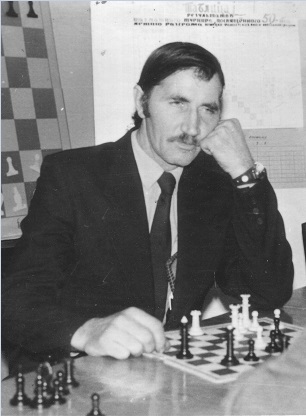A short history of endgame study castling III
by Siegfried Hornecker
Continuing where we left off last June, i.e. after the year 1966, most basic ideas already were explored. As such, we can now concentrate more on interesting ideas connected to castling, instead of just the castling aspect itself. One such idea is happening in a study by Vitaly Kovalenko.
Vitaly Kovalenko
Tikhookeansky Komsomolets 1967, 1st prize (correction).
White to move and win.
The then young Russian master Vitaly Kovalenko (23 May 1947 - 5 March 2014) who won this tourney that first was announced in Primorsky Krai is not to be confused with multiple other people (an actor, volleyball player, or even professor of organic chemistry) of similar names. Judge Vitaly Tyavlovsky noted that not only the two prizewinners but also the first two honorable mentions of this tourney came from the Far East. Of Kovalenko's over 750 endgame studies, around 80 won prizes (source: Kovalenko obituary by Yuri Bazlov, EG 196, July 2014). The next endgame study of our article today coincidentally also is by Vitaly Kovalenko.
Vitaly Kovalenko. Problem October 1968.
White to move and win
Obviously after 1.a7 0-0 the game would be an easy draw. But... can Black even castle? What was his last move? Certainly not with the pawn on f7. But if it was with either the king or rook, castling is impossible. So 1.a7 Ke7 is the only way to stop the pawn for now. How does White continue?
Iosif Krikheli, Prioskaja Pravda 1968, 1st/2nd prize.
White to move and draw
The first five moves are important to find here, Afterwards the positional draw is easy to manifest. So how can White prevent the immediate loss, and what is the continuation afterwards?
Iosif Krikheli (10 May 1931 - 22 September 1988) attended an All-Union congress of chess composers in Sukhumi when he suddenly died, being a chess composer from 16 years old to the last minutes of his life, as Velimir Kalandadze characterized him in EG 98, October 1989, where Kalandadze also wrote:
As a study composer Krikheli worked with the classic themes. His personal preferences concentrated on stalemate, positional draw, and themes from problemdom. He always endeavoured to find that one elusive, light and economical setting to express his chess thought: in his best output one can feel the harmony of form with content.
The total output of Krikheli was over 1500 compositions of many genres.
Johan van den Ende, Schakend Nederland December 1972, 4th prize.
White to move and win (correction)
The study - Mario Garcia added a pawn on d6 four decades after the original publication to correct it - starts off a bit brutal, but after 1.e:d4 Rc2 2.Bf1+ Ke4 3.B:b5 B:b5 4.N:d6+ Kd5! 5.N:b5 R:b2 an interesting position is reached. How does White win here?
Johan J. van den Ende (6 August 1902 - 9 July 2002) was six times champion of Zeeland, the westernmost province of the Netherlands, in practical play. He was an endgame study composer for over six decades, creating around 150 endgame studies.
I found the solution of the following study amusing. Will readers share the same sentiment?
Jindřich Fritz, Szachy December 1973 (correction, winning 2nd prize, in Szachy May 1975).
White to move and win.
How can the pawn on h2 be stopped? Beautiful geometry unfolds but it ends with an... well, not entirely unexpected... castling.
In October of 2017 I quickly wrote about Jindřich Fritz (15 June 1912 - 9 November 1984). Lawyer, Grandmaster for Chess Composition (1976), composer of more than 500 works (endgame studies and problems) which were collected in the 1979 book Vybrané šachové problémy according to the writers at the German Wikipedia. Eric Huber & Vlaicu Crişan date the book to 1959 on their blog, attributing 252 problems and 50 endgame studies to it. So were there multiple editions? Yours Truly found only the 1979 printing of Olympia in Praha (Prague) in a quick search at used book sellers.
Ernest Pogosyants, Shakhmaty v SSSR January 1974, 5th commendation.
White to move and win
It looks as if giving the check on f1, exchanging rooks on f5 and then playing the ending in a precise manner wins. But what is the difference between 1.Rf1+ and 1.0-0+, or is there even a difference? Or should White not exchange rooks at all?
Ernest Pogosyants (5 June 1935 - 16 August 1990) was a victim of medical torture after speaking out against KGB leader Alexander Shelepin (the same Shelepin who then also was heavily involved in bringing Brezhnev to power by overthrowing Khrushchev in 1964). Those experiments left him an insomniac. The numerous sleepless nights were used to compose endgame studies and chess problems, totaling over 6,000 (nearly 2,000 of them endgame studies). This was reported by John Roycroft in the book "A (First) Century of Studies" and gained widespread attention after being included as entry 43 by Dutch author and chess curiosities collector Tim Krabbé in his Open Chess Diary on 25 December 1999. Many of Pogosyants' endgame studies harbor very simple yet interesting ideas, such as the study above. And also often, such as in the study above, the ideas are accompanied by entertaining play. Of course, another famous chess composer, Vladimir Nabokov, whose "Lolita" might be the most misunderstood work in literature history by those who didn't read it, is well-known for his "Poems and Problems", but if Pogosyants published a similar work, he could have included over 4,000 of his own poems and aphorisms...
Stanislav Belokon, Krasnaja Gazeta 1975, 1st prize.
White to move and draw.
Here castling is only the introduction to three stalemates: 1.0-0-0+ Kc3 2.Rd8 Bf7 3.e8Q B:e8 4.R:e8 Bf4+ and the magic begins...

Stanislav Belokon (Belokin) (30 April 1939 - 21 February 1984) was an Ukrainian composer (from Kharkiv) of more than 100 endgame studies. Having lost both hands in an accident at 10 years old, he still became a high-class creator of artistic endgame studies, winning many awards, including the Ukrainian championship four times in the 1970s. Unfortunately it seems that not much is known about Belokon on the internet, I only found the ARVES website's short biography. In the magazine EG, also no further information seems to be provided about him, although we read that his both memorial tourneys received over 100 entries each by international composers. (A bonus study by Belokon is added at the replayable entries, which doesn't fit the theme but I like a lot.)
Ernest Pogosyants, Shakhmaty v SSSR September 1977.
White to move and win.
White wants to play 1.Ra7 Kf8 2.Kf6 Ke8 3.Ra8+ and 4.R:h8, but sadly 1.-0-0! prevents this. So how can White prevent the castling defense? Another small but interesting Pogosyants study.
Valery Maksaev, Shakhmaty v SSSR June 1978, 6th honorable mention.
White to move and win.
Castling is used as a defense here, but eventually White captures the rook. The chase starts with 1.Bc3, and then...? (While editing the study, Yours Truly found there is a dual, but the intended winning way is much easier, so solvers should look only for that.)

Valery Maksaev (born 5 September 1946), according to the information[S3] by Oleg Efrosinin on the ARVES website, studied Russian language and literature before working as a teacher and school director until his retirement in 1995. Since 1965 around 150 of his endgame studies and problems were published. He lives in the Volgograd region (probably this should be "Volgograd oblast[S4] ") for which he participated in chess composition tourneys.
The article "Castling in Studies" by Ernest Pogosyants in EG 56, June 1979, contained only some originals by him, but not all were correct. One was corrected by Stephen Rothwell in the specialized magazine "König & Turm" in 2006 by moving the knight from d5 to d1.
See: EG Archive Part 1 and Part 2
Ernest Pogosyants, EG 56, June 1979 (correction).
White to move and win
The study is short but fun.
1979 was a very interesting year for castling in endgame studies. The magazine Shakhmaty v SSSR held a thematic tourney and the Joachim Reiners Memorial Tourney was also held as a thematic tourney. We shall get to those next time in this series. The winner of said tourney was reprinted in Tim Krabbé's book about chess curiosities, by the way.
For the more experienced solvers, I have a final challenge. It is from 1978, and also replayable below as the second bonus entry. Can you find the solution? The author is not to be confused with a boxer of the same name. We have no biographical information on Vladimir Nikitin (born 3 September 1954), so we also don't know if he was related to the master coach Alexander Nikitin who died last year, but the surname seems to be not uncommon.
Vladimir Nikitin, Shakhmaty v SSSR June 1978, 2nd prize.
White to move and win
Castling plays no big role here, although technically it refutes 1.Rg7? 0-0-0.
As a famous cartoon series said: "That's all, folks..." Well, at least this time.
Links:

























